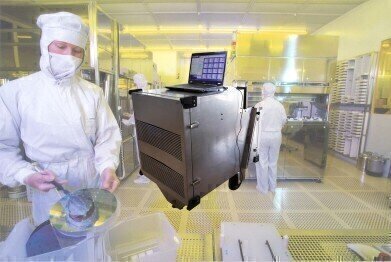Air Monitoring
Airborne molecular contamination by new orion 3100 and uVOC-CAM
Sep 13 2018
Airborne molecular contamination (AMC) can be damaging to a product or process, making it essential to monitor and control on Semi Fabs Clean Room.
AMC is chemical contamination in the form of vapours or aerosols that can be organic or inorganic, and it includes everything from acids and bases to organometallic compounds and dopant.
These chemical vapours can result from a wide range of sources, including cleanroom materials, make-up air, process chemicals, operating personnel, cooling systems and even the outgassing of certain aging materials.
There are primarily two types of AMC: internal and external.Internal sources of AMC involve process chemicals, accidental chemical spills, operating personnel and off-gassing cleanroom construction materials like floor tiles, walls and sealants.External sources include factory emissions, automobile exhaust emissions and farm lands.The entry point of external sources of AMC, incidentally, is generally the fab through the make-up air handling system. Ammonia contamination can be a serious threat. One of the most sensitive steps in the semiconductor manufacturing is photolithography.
Acids as HCl , HF , SO2 etc.. are also dangerous for the production
New Orion 3100 (Transportable and Stationary) to monitor: NH3 (by OFCEAS), HCl (by OFCEAS), HF (by OFCEAS), SO2 (by Pulsed Fluorescence)
The ETG New Orion 3100 uses to detect these compounds the technology Optical Feedback Cavity Enhanced Absorption Spectroscopy which allow:
Improved Sensitivity, Increased Signal Intensity,Reduced Signal Noise, Improved Response Linearity, Direct Intensity Measurement, Self Referencing Device, Self-Stabilisation, Self-Standardisation, Fast Response (measurements reported each second).
Detectivity/Precision (1-σ) is: HCl 0.1 ppb HF 0.1 ppb NH3 < 0.1 ppb
Precision (sub-ppbv in less than 10 seconds). Typically less of 0,1 ppbV
High Sensitivity , Simple to Use , Extremely Wide Dynamic Range , Economical of Own and Operate , Ambient Humidity<98% RH Non-Condensing , Operating Temperature5–45 °C , Power Requirements115/230 VAC; 50/60 Hz; 100 W , Sample Temperature0–50 °C , Fittings:¼” Swagelock or PFA , Output: Rs232, ethernet, usb, Analog 4-20 mA
MAIN ADVANTAGES AND BENEFITS OF OF CEAS TECHNOLOGY: Any radioactive source typical on the IMS technology (real portability), High sensitivity and precision - allows ultra-trace gas detection, Extremely low drift yielding high accuracy with very infrequent calibration, High linearity, Significantly lower cost of ownership than many competing technologies, Interference free / the spectroscopy could be seen, No consumables required as ION CROMATOGRAPHY, High reliability, easy to use, up an running in minutes, Continuous sample flow / measurements, Monitors up to 60 sample locations -- Low cost per sample point, Multiple AMC compounds detected (NH3, Amines, Acids, Chlorides, SO2, HF), With the integrate Permeation oven Calibrator is a simple, effective tool for generating precise gas concentrations for calibrating the uVOC-CAM as well the New Orion 3100, New Orion 3100 may be controlled remotely via the Internet. This capability allows the user to operate the analyzer using a web browser anywhere.
Digital Edition
IET 34.2 March 2024
April 2024
Gas Detection - Biogas batch fermentation system for laboratory use with automatic gas analysis in real time Water/Wastewater - Upcycling sensors for sustainable nature management - Prist...
View all digital editions
Events
Apr 30 2024 Melbourne, Australia
Apr 30 2024 Birmingham, UK
May 03 2024 Seoul, South Korea
May 05 2024 Seville, Spain
May 06 2024 Minneapolis, MN, USA


















